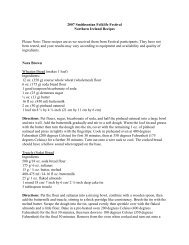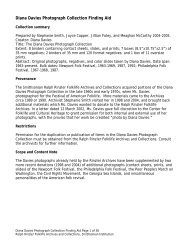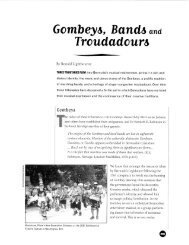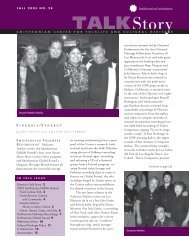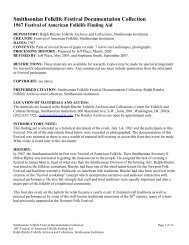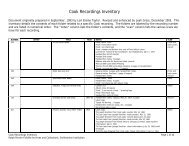Who Owns Traditional Medical Knowledge? - Smithsonian Center ...
Who Owns Traditional Medical Knowledge? - Smithsonian Center ...
Who Owns Traditional Medical Knowledge? - Smithsonian Center ...
Create successful ePaper yourself
Turn your PDF publications into a flip-book with our unique Google optimized e-Paper software.
MAKING HERITAGE LEGIBLE 183<br />
37. For a description of the dominance of low-caste epistemologies in Portuguese botanical texts,<br />
see Boxer, “Two Pioneers of Tropical Medicine.” See also Grove, Green Imperialism, Chapter 8; and<br />
Grove, “Indigenous <strong>Knowledge</strong> and the Significance of South-West India.”<br />
38. Ranjit Devraj, “325-Year-Old Dutch Work on Kerala’s Plant Wealth Revived,” Asia Times Online,<br />
May 8, 2003 http://www.indiasocial.org accessed September 19, 2006; see also Mohan Ram,<br />
“On the English Edition of Van Rheede.”<br />
39. For earlier versions of this argument, see also Manilal, Botany and History of Hortus Malabaricus;<br />
Fournier, “The Hortus Malabaricus of Hendrik van Rheede tot Drakenstein”; and Heniger,<br />
Hendrik Adriaan Van Rheede.<br />
40. See Mohan Ram, “On the English Edition of Van Rheede’s Hortus Malabaricus.”<br />
41. Jayaraman,“Biopiracy Fears Cloud Indian Database,” December 5, 2002, http://www.scidev.net<br />
accessed September 24, 2006.<br />
42. See for example, The Economist, “Finding drugs in the library,” September 5, 2004.<br />
43. UN Draft Declaration on the Rights of Indigenous Peoples, 1993, http://www.iwgia.org/<br />
sw248.asp accessed September 23, 2006.<br />
44. See Suvarna Kumar, Deccan Herald, 2004. For more on Ezhava political claims, see also Srinivasan,<br />
“The Year of Sree Narayana Guru,” August 30, 2004 http:www.rediff.com accessed September<br />
24, 2006; and Cherian, Perspectives on Kerala History http://www.keralahistory.ac.in/<br />
casteandsocial.htm accessed September 24, 2006.<br />
45. Watkins, “Cultural Nationalists.” For similar views on cultural rights, see Robbins and Stamatopoulou,<br />
“Reflections on Culture and Cultural Rights.”<br />
46. Shiva, The Neem Campaign, 4; for more on the Neem Campaign, see Third World Network,<br />
A Case of Biopiracy http://www.twnside.org.sg/title/pir-ch.htm accessed September 24, 2006.<br />
47. Convention to Safeguard the Intangible Cultural Heritage, 2003, Article 12, section 1.<br />
48. Chander and Sunder, “Romance of the Public Domain,” 1358.<br />
49. Dirks, Castes of Mind, provides a good historical overview of archive creation in nineteenthcentury<br />
India.<br />
50. See Chander and Sunder, “Romance of the Public Domain,” 1357–1358; Mashelkar, “Intellectual<br />
Property Rights and the Third World,” 12.<br />
51. Mashelkar, The Story of the TKDL, 16.<br />
52. Padma, T.V. “Digital Library to Protect Indigenous <strong>Knowledge</strong>,” January 10, 2005, Science and<br />
Development Network http://www.scidev.net accessed September 15, 2006.<br />
53. See WIPO, Report on Intellectual Property and <strong>Traditional</strong> <strong>Knowledge</strong>, http://www.wipo.int/<br />
freepublications/en/tk/wipo_pub_920.pdf accessed September 24, 2006.<br />
54. See Harrison, “Community Biodiversity Registers”; Utkarsh, “Documentation of <strong>Traditional</strong><br />
<strong>Knowledge</strong>”; Downes and Laird, “Community Registers of Biodiversity-Related <strong>Knowledge</strong>.”<br />
55. SARAI’s conference on digital technology information and traditions explored many of these<br />
issues.<br />
56. For a history of this professionalizing schism, see for instance, Leslie, Asian <strong>Medical</strong> Systems;<br />
Leslie and Young, Paths to Asian <strong>Medical</strong> <strong>Knowledge</strong>; and Brass, “The Politics of Ayurvedic Education.”<br />
57. Some of this history is recounted in Shiv Sharma’s Ayurvedic Medicine; see also Leslie in Paths<br />
to Asian <strong>Medical</strong> <strong>Knowledge</strong>, 177–208, for a biographical history of leading Ayurvedic advocates.<br />
58. See Report of AYUSH, goverment of India, 2003, http://www.indianmedicine.nic.in html/<br />
ismh/annual/annual.htm accessed September 24, 2006.<br />
59. See Brown, “Heritage Troubles” or “Can Culture be Copy-righted” for a description of this<br />
process.<br />
60. Report of the Department of Ayurveda, Yoga, Unani, Siddha and Homeopathy, on Ayurveda,<br />
New Delhi, 2004.<br />
61. Letter to the editor, Indian Express, September 4, 2004.<br />
62. See text of speech at the Government <strong>Center</strong> for Ayurvedic, Siddha and Homeopathic Medicine,<br />
2003. For descriptions of the two court cases, see Weil, “<strong>Who</strong> <strong>Owns</strong> the Nataraja”; and Davis,<br />
Lives of Indian Images; see also Reddy, “The Memory of Divine Objects.”



